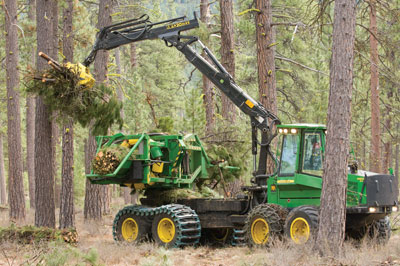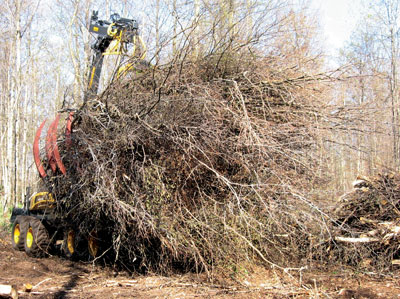
Slash Solutions
February 24, 2010
By
Heather Hager
For operations that get biomass straight from the forest, the first step in the supply chain is deciding how to collect and transport the leftover slash from logging or thinning. Efficient slash handling can be difficult because the material varies in shape and size and lacks density. In an effort to make slash recovery cost effective while maintaining a clean, high-quality product, three machines are going where none have gone before: into the forest.
For operations that get biomass straight from the forest, the first step in the supply chain is deciding how to collect and transport the leftover slash from logging or thinning. Efficient slash handling can be difficult because the material varies in shape and size and lacks density. In an effort to make slash recovery cost effective while maintaining a clean, high-quality product, three machines are going where none have gone before: into the forest.
 |
|
| The John Deere 1490D Energy Wood Harvester compresses slash by up to 80% of its loose volume. (Photo: John Deere Forestry) |
|
 |
|
| The Ponsse BTS compresses slash and can also handle roundwood. (Photo: Ponsse) |
The Bruks 805 forwarder-mounted mobile chipper, the John Deere 1490D Energy Wood Harvester, and the Ponsse Brush Transport System all have one thing in common: they densify slash while collecting it. Each, however, uses a different strategy to accomplish this.
Mobile Chipping
Bruks’ strategy is to bring the chipper to the slash, rather than dragging the slash to a roadside chipper or grinder, says Blase Grady, vice-president of mobile chipping North America for Bruks Rockwood. A drum chipper, with 450-hp diesel engine, mounts directly on any brand of forwarder and blows chips into a self-contained chip bin. Once the bin is full, the forwarder moves to the roadside and dumps into a waiting chip van or roll-off container.
The chipper handles slash, tops, limbs, and whole logs up to 20 inches in diameter. The self-dumping chip bin holds about 7.3 bone-dry tonnes and rises up to 14 feet for dumping into transportation containers. The chipper is fuel efficient and has a high peak production rate for its size, says Grady.
“It fits in well in thinning and cut-to-length (CTL) operations,” says Grady. “Once the logging operation leaves, the equipment can come back in and move about the area where they’ve done the logging to collect and chip all the slash that’s left.”
“The efficiency and cost savings of a one-piece operation is key,” he adds. “Logging operations can leave the slash in windrowed piles to dry, and when they go back to chip, send one operator and one machine.” Other benefits are clean chips (if the slash is clean) and the ability to go where chip vans cannot.
Grady says that most biomass harvesting in Scandinavia is done using this type of machine. “We have been making them for 30 years. We probably have 150 operating in Europe right now,” he says. The forwarder-mounted chipper is relatively new in North America, with one currently working in Nova Scotia. Three more are being manufactured in Sweden for use in Colorado, California, and Oregon. In the Canadian context, the mobile chipper is well suited to smaller cut blocks, where bringing in a large chipper/grinder crew is not economical.
Slash Tubes
John Deere’s strategy is to densify slash by tying it into compact bundles, a strategy tried by several other Scandinavian suppliers over the years. Its 1490D Energy Wood Harvester, also known as a slash bundler, is mounted on a forwarder. “A grapple on the forwarder picks up slash and puts it into a feed chute. The feed chute pulls it in, compresses it, and then wraps the compressed slash with baling twine,” explains Mike Schmidt, manager of forestry renewables for John Deere Forestry. The process is continuous, like making sausage. As the compressed slash leaves the machine, bundles are cut to desired length and fall to the ground.
Finished bundles are 24 to 30 inches in diameter. “Two 10-foot bundles gives you about 1 ton (0.9 tonnes) of green material at 50% moisture content,” says Schmidt. Most operations produce 20 to 40 bundles/hour, depending on operating conditions. He adds, “We’ve put entire invasive western juniper trees with 24-inch butts through the machine without delimbing them, so you can put very large pieces through if you need to.”
“In clear-cuts, if you know before you log a site that you’re going to be bundling that slash, then the machines that process the timber can orient the slash so that a bundler can come through and pick it up out of windrows. That eliminates most of the site prep work for replanting,” explains Schmidt. In thinning and CTL operations, the slash bundler can move within the remaining stand. A trailer-mounted model is under development for whole-tree operations, in which processing occurs at roadside. For a logger interested in producing biomass, says Schmidt, this will eliminate both the expense of an additional forwarder and the need to maintain chipping or grinding equipment.
Bundles are transported using standard logging equipment. “There are a lot of logging roads, especially in the western United States, where you cannot get chip vans on the road. But if you can get a log truck into the site, you can bring these bundles out,” explains Schmidt. In addition, the bundles can be piled and left to dry or stored until use without worrying about spontaneous combustion or degradation.
The slash bundler is manufactured in Finland and has been available in Europe since 2002, with about 75 units operating in 16 European Union countries. It has recently entered the North American market, with working units in Michigan, Texas, Washington, and Maine. Typically, it requires a large biomass combustion plant with a large grinder as end user to handle the bundles.
Going Forward
The newest strategy in slash handling is Ponsse’s Brush Transport System (BTS). It comprises forwarder-mounted curved bunk arms that move up and down, compressing slash as it is piled onto the forwarder. The original model has bunk arms at fixed locations on the forwarder. A newer model has bunk arms that can be moved closer to the front or back of the forwarder, depending on the distribution of slash in the load space, says Stacy Wagler, technical support and product development for Ponsse North America. The compression bunks can attach to any type of forwarder, provided that it has at least 15- to 16-tonne capacity. “If you put the bunks on too small of a machine, you will have trouble because you will overload the machine,” says Wagler.
By compressing the slash, the BTS can double or triple the slash-carrying capacity of a standard forwarder, depending on the tree species. “We’ve done some comparison with a standard 16-tonne forwarder that would only get between four and six tonnes with the load maxed right out. With these bunks, we’re getting between 12 and 15 tonnes per load,” explains Wagler. He says the BTS particularly increases efficiency for hardwood slash. “Because there’s so much air in the crowns, they need to be broken and crushed down in the load space to make it efficient.” Increasing the load capacity results in less travelling and fewer loads required than with a standard forwarder. This means less fuel consumption and greater efficiency.
The BTS was developed for and introduced in North America in 2007 and is not currently available elsewhere. One unit is working in British Columbia, and there are several in the U.S. Great Lakes area. Generally, this option requires considerably less capital investment for loggers just getting into the biomass business, but assumes some form of roadside grinding or chipping.
These machines are designed to increase the mobility and efficiency of gathering slash in the field to make forest biomass collection an economical venture. Which option is best for the user will depend on his/her specific operational conditions, as well as the final purpose and end user of the biomass.
Print this page